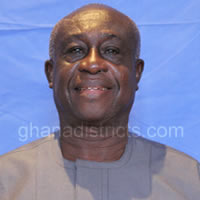Population Size and Distribution
Bosomtwe District had a population of 93,910 in 2010 with male population representing 47.7 percent and that of the female population representing 52.3 percent. This gives a sex ratio (i.e. number of males for every 100 females) of 91.2 showing that there are more females than males in the District. The projected population for 2017 is 119,444 using a population growth rate of 3.47 percent. The District’s population density is 284 persons per sq.km.
Rural Urban Split
The District has a more rural population (65,535) than urban population (28,375). The District is primarily rural (69.7%). The urban settlements include Esereso, Feyiase, Aputuogya, Jachie and Kuntanase. Some of the rural settlements include, Abono, Piase, Obbo, Mim, Bonkorkor, Deduako, Nnuaso, Apinkra etc. Figure 1.10 shows the urban and rural settlements in the district.
Figure 1.9: Urban and Rural Settlements in the Bosomtwe District

Age-Sex Structure
The population pyramid (Fig. 1.12) shows that the District has a youthful population, comprising large proportion of children under 15 years, and a small proportion of elderly persons (65 years and older). The proportion of males in the age group 0 - 14 years (20.5%) computed, is slightly higher than the females (20.0%). Similarly, proportion of the age group 40 – 44 years of the male population (2.4%) is slightly higher than the females (2.3%), while the other age groups have females outnumbering the males in all the other age cohorts. As the age cohorts increase, proportions of males to females decrease except for the age group 70-74 years. The age structure in Figure 1.10.shows a pattern of population decreasing as age increases, suggesting the effect of mortality and migration.
Source: Ghana Statistical Service, 2010 PHC
Age Dependency Ratio
The Age Dependency ratio is the relationship between persons in the “dependent age” to those in the “economically productive age”. It is measured per 100 populations. The Dependent age is defined as the population under age 15 and those above age 64. The economically productive age is also defined as the population between age 15 and 64.
The District has a high age dependency ratio of 83.2. This means that there are 83 persons in the dependent ages for every 100 persons in the working ages for the District. In terms of sex, the males are more dependent (87.18) than females (79.71) in the District. Again, the age dependency ratio in the rural areas is relatively higher (89.34).
Implications of District Population for development
v Because of the high growth rate (3.47%) there is the urgent need for the intensification of educational programmes on family planning in order to reduce the high growth rate.
v The large proportion ( 92.2%) of the population in the 0 - 59 years is an indication of a large potential labour force for the district if given the needed training
v The large pool of youth in the population calls for the provision of socio-economic facilities and services to train the people and to reduce pressure on existing facilities
v With the youth migrating to the urban areas particularly Kumasi, Accra and other urban centres in the district like Esereso, Aputuogya and Kuntanase in search of jobs, farming is left to the ageing farmers.
Migration (Emigration and Immigration)
Migrants are defined as persons who are enumerated in a place different from where they were born. The 2010 PHC sought to find out the place of birth and the number of years a person had lived in a particular place. Out of the entire population of 93,910 in the District, 44.9 percent computed are migrants who have lived in the District for some length of time. Most of the migrants have lived in the District between 1- 4 years, for example, 42.2 percent of migrants born elsewhere in the region (Ashanti) and 29.3 percent of those born outside Ghana have lived in the District within the past four years. For migrants born in other regions outside the Ashanti Region, the highest proportion come from Upper East (13%), followed by Upper West (11.5%) while Greater Accra recorded the least (4.6%).
The forms of migration in the district include rural –urban migration, urban –rural, rural-rural and urban to urban. However the rural urban migration is the predominant one.Rural urban migration is a form of so-called internal migration which means a movement within a country. It refers to the movement of people from the rural areas to the urban centres. This change of residence is often connected with migration of labour and a career change from primary to second or third sector. It is obvious these developments always show two ideas, one side or new destinations gains population whereas the other side, the area of origin looses people. There are different reasons that cause rural-urban migration. They are the so-called push and pull factors. The push factors are factors that force migrants out of rural areas. Whilst the pull factors are the factors in the urban centres that attract the rural folks to urban areas. Most rural folk in the district migrate to places like Kumasi, Accra which are outside the district. Within the district the people usually migrate to places like Esereso, Aputuogya, and Kuntanase.
The Factors and determinants of migration are rather diverse and they can be split up in economic and non-economic reasons
v Economic push factors include unemployment or under-employment in rural areas
v Low wages and no assets in the rural communities
v Lack of land, which is sometimes due to inheritance system that split the land among a large number of people’ making it less productive
Non-economic push factors play an additional role and mainly include poor rural infrastructure in general. ie. poor living conditions referring to housing, education possibilities and health care.
Economic pull factors include factors that attract people to move into cities caused by higher demand of labour.
Non-economic pull factors include social factors such as hope for better health care and education provision of the urban facilities and as a way of life in general as well as factors like family networks.
Development Implications of migration in the district
The increasing numbers of people moving to the large urban areas in the district cause these areas to grow and thereby putting pressure on the facilities. This explains why urban centres like Aputuogya, Esereo, Jachie and Pramso have high school enrolment rates. There is therefore the need to build more classrooms to accommodate the increasing enrolment.
Apart from the enrolment rate, there is also low sanitation and water coverage in these areas. There is always heaped refuse dumps in these communities. Measures have to put in place to provide additional refuse containers and water facilities.
One negative effect is rural depopulation which means that large numbers of working age people migrate from the rural areas to earn more money in the urban centres. But then, they leave behind the very old and the very young causing further problems in rural development as the young, skilled adult are missing. In the district for instance the farmers are aging and therefore affecting agriculture productivity.
The positive aspect of this migration is that the migrants send remittance to their families in their area of origin and could contribute to further development in the village of origin.
However, because of the negative effect of migration in the rural areas the District Assembly will collaborate with its development partners to put in measures to improve the living conditions in the rural communities to stem the rate of migration in the district. These will include:
v Improving road condition
v Improving educational infrastructure
v Improving health service delivery
v Improving agriculture to make it more attractive to the youth
v Enhancing sanitation service delivery
v Increasing access to potable water
v Facilitating the creation of decent jobs for the youth
Gender Equality
According to the 2010 PHC, Bosomtwe District has a population of 93,910. The male population represents 47.7 percent and that of the female population represents 52.3 percent. In this regard, the relevance of gender mainstreaming in local development cannot be over emphasized.
Gender refers to the social construction of female and male identity. It can be defined as more than biological differences between men and women and includes the ways in which those differences, whether real or perceived, have been valued, used and relied upon to classify women and men and to assign roles and expectations to them. It also refers to socially constructed power relations between men and women as social categories in which women are invariably subjected to men.
Generally, development projects affect women and men differently and women and men will have different impact on projects. As the two key stakeholders, both must be involved in identifying problems and solutions if the interests of the community as a whole are to be furthered. Bridging the gender gap has always been a global phenomenon and Ghana is no exception. To deal with this issue, the Bosomtwe District Assembly has kept track of information regarding gender in the major sectors in the District. Table 1.11 shows the gender profile of the District.
Date Created : 11/18/2017 3:11:30 AM





 facebook
facebook twitter
twitter Youtube
Youtube TOLL FREE 0800 430 430
TOLL FREE 0800 430 430 +233 593 831 280
+233 593 831 280 GPS: GE-231-4383
GPS: GE-231-4383 info@ghanadistricts.com
info@ghanadistricts.com Box GP1044, Accra, Ghana
Box GP1044, Accra, Ghana